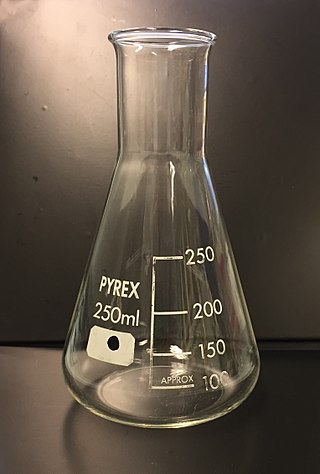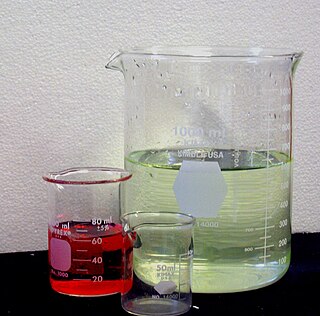
An Erlenmeyer flask, also known as a conical flask or a titration flask, is a type of laboratory flask which features a flat bottom, a conical body, and a cylindrical neck. It is named after the German chemist Emil Erlenmeyer (1825–1909), who created it in 1860.

Laboratory glassware refers to a variety of equipment used in scientific work, and traditionally made of glass. Glass can be blown, bent, cut, molded, and formed into many sizes and shapes, and is therefore common in chemistry, biology, and analytical laboratories. Many laboratories have training programs to demonstrate how glassware is used and to alert first–time users to the safety hazards involved with using glassware.

Pyrex is a brand introduced by Corning Inc. in 1915 for a line of clear, low-thermal-expansion borosilicate glass used for laboratory glassware and kitchenware. It was later expanded to include kitchenware products made of soda-lime glass and other materials.

In laboratory equipment, a beaker is generally a cylindrical container with a flat bottom. Most also have a small spout to aid pouring, as shown in the picture. Beakers are available in a wide range of sizes, from one milliliter up to several liters. A beaker is distinguished from a flask by having straight rather than sloping sides. The exception to this definition is a slightly conical-sided beaker called a Philips beaker. The beaker shape in general drinkware is similar.

A Fleaker is a brand of container for liquids used in the laboratory. It can be described as a cross between the Griffin beaker and the Erlenmeyer flask.

A policeman is a hand-held flexible natural-rubber or plastic scraper. The common type of it is attached to a glass rod and used in chemical laboratories to transfer residues of precipitate or solid on glass surfaces when performing gravimetric analysis. This equipment works well under gentle, delicate and precise requirement. A policeman also comes in various sizes, shapes, and types. Some of them come in one-piece flexible plastic version and some in stainless. The origin of the policeman and its name cannot be identified for sure but some clues led back to the 19th century from German chemist Carl Remigius Fresenius.

Corelle is a brand of glassware and dishware. It is made of Vitrelle, a tempered glass product consisting of two types of glass laminated into three layers. It was introduced by Corning Glass Works in 1970, but is now manufactured and sold by Instant Brands.

A cage cup, also vas diatretum, plural diatreta, or "reticulated cup" is a type of luxury late Roman glass vessel, found from roughly the 4th century, and "the pinnacle of Roman achievements in glass-making". Diatreta consist of an inner beaker and an outer cage or shell of decoration that stands out from the body of the cup, to which it is attached by short stems or shanks. About fifty cups or, more often, fragments have survived, and there are only a few in near-complete condition. Most have a cage with circular geometrical patterns, often with an "inscription", or phrase in letters above the reticulated area as well. Some have a flange, or zone of projecting open-cut moulding, above the lower patterns and below the lettering.

A glass stirring rod, glass rod, stirring rod or stir rod is a piece of laboratory equipment used to mix chemicals. They are usually made of solid glass, about the thickness and slightly longer than a drinking straw, with rounded ends.

A rummer was a type of large drinking glass studded with prunts to ensure a safe grip, popular mainly in the Rhineland and the Netherlands from the 15th through the 17th century. Rummers lacked the flared bowl of the Berkemeyer and had much thinner walls. The hollow base was built up by coiling strands of molten glass around a conical core. Römers were quite distinct from the Berkemeyers, but both types evolved from the German "cabbage stalk" glasses which were cylindrical with prunts. Römers are usually green in colour and with Berkemeyers were sometimes engraved with images and inscriptions.

An Imperial Eagle beaker, or eagle glass, was a popular drinking vessel from the 16th until the late 18th century in the Holy Roman Empire. The enamelled glass was decorated with a double-headed eagle, usually in the shape of a Quaternion Eagle. The Reichsadler means "Imperial Eagle" or double-headed eagle which was the emblem of the empire, while "humpen" refers to a cylindrical drinking glass. These beakers became the essential medium to represent the most popular explanatory model for the emergence of the Empire: the quaternion theory as represented by Hans Burgkmair.

Sasanian Glass is the glassware produced between the 3rd and the 7th centuries AD within the limits of the Sasanian Empire of Persia, namely present-day Northern Iraq, Iran and Central Asia. This is a silica-soda-lime glass production characterized by thick glass-blown vessels relatively sober in decoration, avoiding plain colours in favour of transparency and with vessels worked in one piece without over- elaborate amendments. Thus the decoration usually consists of solid and visual motifs from the mould (reliefs), with ribbed and deeply cut facets, although other techniques like trailing and applied motifs were practised.

Glass art refers to individual works of art that are substantially or wholly made of glass. It ranges in size from monumental works and installation pieces to wall hangings and windows, to works of art made in studios and factories, including glass jewelry and tableware.

Hedwig glasses or Hedwig beakers are a type of glass beaker originating in the Middle East or Norman Sicily and dating from the 10th-12th centuries AD. They are named after the Silesian princess Saint Hedwig (1174–1245), to whom three of them are traditionally said to have belonged. So far, a total of 14 complete glasses are known. The exact origin of the glasses is disputed, with Egypt, Iran and Syria all suggested as possible sources; if they are not of Islamic manufacture they are certainly influenced by Islamic glass. Probably made by Muslim craftsmen, some of the iconography is Christian, suggesting they may have been made for export or for Christian clients. The theory that they instead originate from Norman Sicily in the 11th century was first fully set out in a book in 2005 by Rosemarie Lierke, and has attracted some support from specialists.
Borosil is an Indian glassware company based in Mumbai. The company is one of the largest glassware producing companies in India with a significant presence in USA and The Netherlands.

DURAN is a brand name for the internationally defined borosilicate glass 3.3 produced by the German company DURAN Group GmbH since 2005 under license from the Schott AG, which was the first to develop it, and which sold it from 1893 until the equity carve-out of the DURAN Group in 2005. Because of its high resistance to heat and temperature changes, as well as its high mechanical strength and low coefficient of thermal expansion, DURAN, which Pyrex from Corning is similar to, is not only used for laboratory devices but also in cathode ray tubes, transmitting tubes, and speculums.

Byzantine glass objects highly resembled their earlier Hellenistic counterparts during the fourth and early fifth centuries CE in both form and function. Over the course of the fifth century CE, Byzantine glass blowers, based mostly in the area of Syria and Palestine, developed a distinct Byzantine style. While glass vessels continued to serve as the primary vehicles for pouring and drinking liquid, glassware for lighting, currency and commodity weights, window panes, and glass tesserae for mosaics and enamels also surged in popularity. Following the Arab conquests of the seventh century CE, large quantities of glass were imported from the Levant, which continued to produce raw and manufactured glass. Scholars once believed that glassware was an expensive luxury good reserved for the upper strata of society, however, recent archaeological excavations have unearthed a considerable quantity of unadorned glassware intended for lower-class residents.

Enamelled glass or painted glass is glass which has been decorated with vitreous enamel and then fired to fuse the glasses. It can produce brilliant and long-lasting colours, and be translucent or opaque. Unlike most methods of decorating glass, it allows painting using several colours, and along with glass engraving, has historically been the main technique used to create the full range of image types on glass.
Věra Lišková was a Czech glass artist. She is known for pioneering the use of borosilicate glass or pyrex in glass art.



















